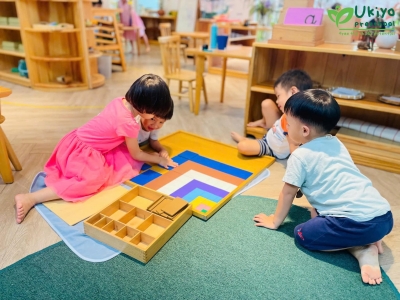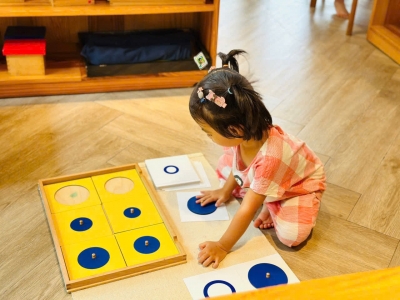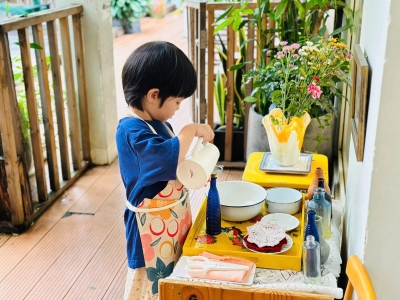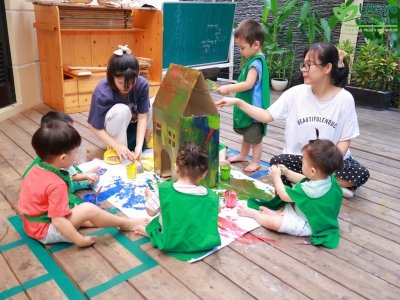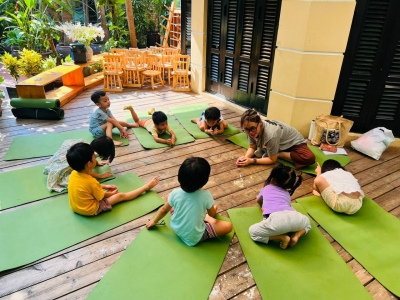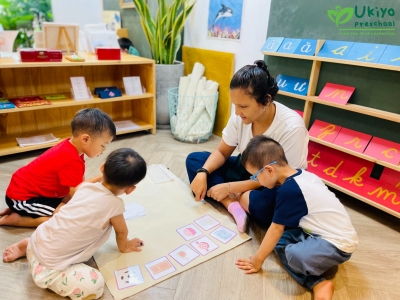YOUR CHILD HAS WORK OF HIS OWN
Nowadays enlightened parents have left far behind them the obsolete idea that children are empty little vessels requiring to be filled by grown-ups with information and manners. They have learnt that the child himself has an important contribution to make to his own development, that they must study his specific needs if they are to prepare him in the best possible way for his grown-up life.
There is, however, still a great deal of confusion about the exact nature of the contributions which the child and the adult shall each make in their joint work of learning and teaching. We hear much about the ‘spontaneous activity’ of young children, and are told that the child should be allowed to use this activity to the fullest extent in order that his development shall take place naturally and fully.
On the face of it this sounds splendid, but there is considerable danger in subscribing to such a theory before we have clearly understood what is meant by spontaneous activity. Actually these words are often used to refer to either of two entirely different forms of activity.
For instance, a child who is extremely sensitive to outside influences and responds to them continuously with vague movements is often described as possessing a great deal of spontaneous activity.
On the other hand, there is the child who fixes his interest on some object in his environment, often for quite long stretches of time. He touches it, twists, turns it, brings it into relation with other objects, and is quite undisturbed if an interrupting adult offers other objects for his attention before he has exhausted the one he is interested in. This child too is described as possessing spontaneous activity.
It will be seen immediately that the two types of activity are very different. When a child reacts quickly to outside disturbances he is subject to any wind that blows, his movements are undirected by any need of his own, he is vague and dependent.
The activity of the second child is not vague but formative. He has no need of adult influences to call out his activity, a tranquil environment; suitable to the interests of his age and the freedom to follow the promptings of his own inner need are sufficient for him. This child has true spontaneous activity; his development unfolds from within through his activity working purposively on the objects in his environment. He is both teacher and learner, who forge for himself his own mental growth and independence.
This true spontaneous activity lies within each normal child. We can spoil it by overstimulation or by starvation. If we impose tasks and discipline on children which are in no way related to the rate and needs of their own growth, or if we deprive them of simple objects for their activity to work on, we run the great risk of turning natural independence into unnatural dependence, true spontaneous activity into vague movement, and the naturally developing child into a dissatisfied little being with no real work of his own.
Is it through work alone that a child develops.
We grown-ups are inclined to think that no one really works but ourselves. It is we who earn a living, it is we who have built us the civilization we live in, we who work looking after our homes and children ... What work does a small child do? A few lessons perhaps, a little task to help mother ... and the rest–play, an aimless carefree unimportant pastime. Of course, we grown-ups work, I don’t deny that. But I do most emphatically say that a child works quite as hard as we do, but in his own way. This is the important thing to remember. Grown-ups are producers, working in a material world. We don’t mind delegating or sharing our work, our watchword is ‘labor saving’, we devise all sorts of mechanical means from vacuum cleaners to calculating machines by which to lighten our work and yet achieve the desired end.
Now consider for a moment the work of a small child. His work is to create the man he will be. But he is not conscious of this end, he is conscious only of the means he employs. From a baby’s first kicking through his successive attempts to hold his head up, sit up, grasp his toes, his mother’s finger, and bright colored objects, he is working at his own muscular and mental development. Nobody can give him direct help with this; no mechanical device can save him the labor of co-coordinating his muscles or exercising his mind.
The misunderstanding arises because the child does not work with conscious purpose as a producer. When he is old enough to want to do as grown-ups do, it is not the purpose of the activity that interests him, but the doing. He does not want to learn to wash himself and dress himself so that he may be a well-dressed clean little boy; his interest lies in learning and making over and over again the movements necessary to put on his clothes and washes his face. Have you ever seen a child, flushed with the new accomplishment of putting on his socks and shoes, dеliberately take them off in order to go through the whole performance again?
In our schools we allow the children to use their spontaneous activity by offering them objects which call for movements appropriate to their stage of development; in this way they learn through doing. This is their work, and their concentration and perseverance is astonishing.
But young children do not have to go to school to work. Playtime for them is a time of learning by practice. Every new movement which a little child makes is tried first of all tentatively and then repeated until the first clumsiness is gradually refined to an exact movement. Every plaything he uses is a tool for his work.
What if this child knows nothing of the end he will achieve? If he is allowed to use his spontaneous activity in a tranquil environment without interference or unasked for help, he is indeed engaged in a most important work: he is building the man he will one day be.
Chapter 10, Maria Montessori Speaks to Parents Book
Others



